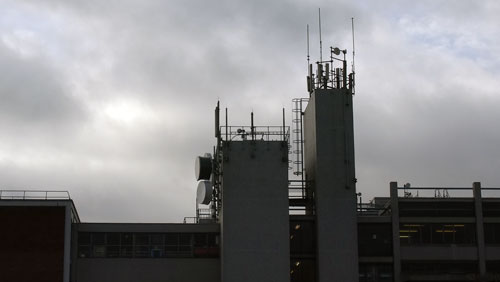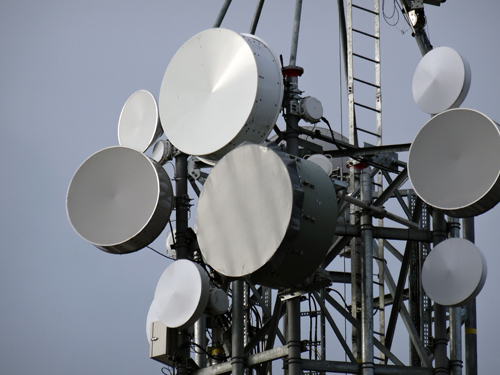This essay is the second of a series of reports from The Nor, an investigation into paranoia, electromagnetism, and infrastructure. It results from a series of excursions undertaken on the 3rd, 17th, and 29th of November, 2014. The locations and associated documents appear on the map of the Nor, and photos are available on Flickr.
If you take the back off an old transistor radio – one of the battery-powered ones, with a physical tuning dial – you’ll see a couple of coils of copper wire. Tune the radio to a station high up in the FM band, take a screwdriver and gently separate the wires, and you’ll hear the station start to fuzz out. As you spread the coils further apart, and turn the dial, other voices come into range. A plane circles overhead, and you hear the pilot speaking to the tower. A scratchy, recorded voice details cloud levels and visibility ranges. Bleeps and whistles invade the spectrum.
The coils of copper wire control and limit the frequency range of the radio, confining it to the FM band, which in most countries is between 87.5 and 108.0 MHz. By spreading the coils a little wider, the range moves up into the Civil Aviation Band, or Airband, between 108 and 138MHz. Heathrow Tower is at 118.5. ATIS, the recorded weather information, is on 113.75. At 113.60 is the Heathrow VOR.
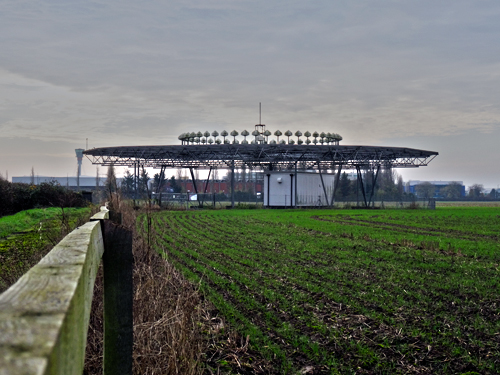
Heathrow
I spent much of this summer on a rooftop in South London, engaged in a project called The Right To Flight. I was flying an eighteen-foot balloon over the city, in memory of Gaspard-Félix Tournachon, in mourning for the web we lost, in hope for the network we might build.
Tournachon – aka Nadar – was a French photographer, journalist, novelist, and balloonist. In 1858, he took the first ever aerial photographs, from a balloon of his own design. In 1866, he published a book entitled Le Droit au Vol, which laid out his belief that the balloon was the ultimate democratic instrument, in which mankind would float free of servitude and tyranny. His friend Victor Hugo agreed, stating that flight would “bring an immense and totally peaceful revolution. It will bring a sudden golden dawn, a brisk flinging open of the ancient cage door of history, a flooding in of light. It will mean the liberation of all mankind.”
In September 1870 the Prussian forces of Crown Prince Frederick III laid siege to Paris. The citizens ate rats and horses, and Nadar petitioned the city fathers to set up the first European military balloon corps, the No. 1 Compagnie des Aérostiers of the République Français. Over the course of the emergency, which lasted until the end of the January, over sixty flights left the besieged city, carrying mail and dignitaries – and also providing crucial surveillance of the enemy lines.
The American Civil War had already seen aerostats in action for several years, in the form of Thaddeus Lowe’s Union Army Balloon Corps. Carrying a telegraph aloft with him at the First Battle of Bull Run, Lowe directed artillery fire onto the Confederate encampment.
The circuit was made, the air militarised, and Nadar and Hugo’s potential new utopia became a domain of warfare, and surveillance.
Sitting on that Peckham rooftop on long, sunny afternoons, I watched the planes and tuned my radio, dowsing the flight paths into Heathrow and City Airport. Depending on their departure point and the prevailing weather, planes approaching Heathrow are guided by National Air Traffic Control to one of four stacks on the edges of the urban conurbation. Clockwise from the North-West, these are Bovingdon, Lambourne, Biggin and Ockham: vertical waiting rooms, where the planes await clearance to land. Each stack is named for the navigation beacon at its base: the VOR.
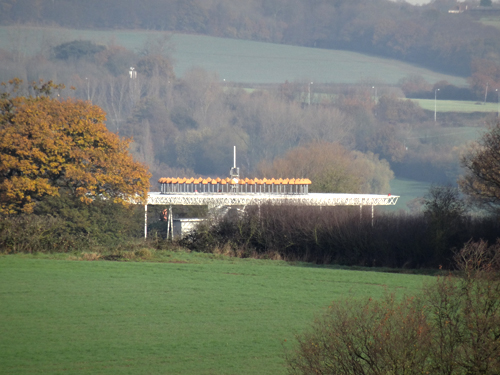
Lambourne
In his book Spycatcher, disgruntled MI5 officer Peter Wright detailed the RAFTER program, a joint effort by the MI5 and GCHQ Radiation Operations Committee. The ROC was tasked with monitoring Soviet communications with KGB agents in the UK, and RAFTER was a secret technique Wright developed for detecting when radios were tuned to a particular frequency. By transmitting on the same frequency as the KGB’s signal, RAFTER could pinpoint the location of the receiver. In the late fifties, vans packed with radio equipment trawled the streets of London for the squawk of illegal traffic.
RAFTER took to the air as well. ROC arranged for a Royal Air Force transport plane to be fitted with the same equipment as the vans, which made regular sweeps through the airspace over the city. When signals were detected, the area below could be flooded with vans to pinpoint the signal. Agents on foot stalked the suburbs looking for unusual aerials puncturing the rooftops.
“The RAFTER flights were a kind of agony,” recalled Wright. “I spent night after night up in the indigo sky, listening to the signals coming in from Moscow, insulated from the deafening sound of the plane’s propellors by headphones. Down below, somewhere amid the endless blinking lights of the London, a spy was up in an attic, or out in a car, listening too. I knew it. I could hear him. But I had no way of knowing where he was, who he was, whether he worked alone or as part of a ring, and, most important of all, what Moscow was telling him. I was caught between knowledge and the unknown, in that special purgatory inhabited by counterespionage officers.”
From my South London vantagepoint, the sky is filled with aircraft. There are the transatlantic flights into Heathrow, the 747s and cetacean A380s. Cityjets dip towards City Airport. The Metropolitan Police, Air Ambulance, and traffic helicopters dash across the skyline; more purposeful private ones buzz towards the heliport at Battersea. Occasionally, smaller planes, unmarked Cessnas, wing in from the south and perform rapid low-altitude circles over the capital. Over East London, I watched a flight of Britten-Norman Islanders loiter high in the sky for hours. Sometimes the Cessnas pop up on the publicly-accessible civilian radar. The Islanders, not so much.
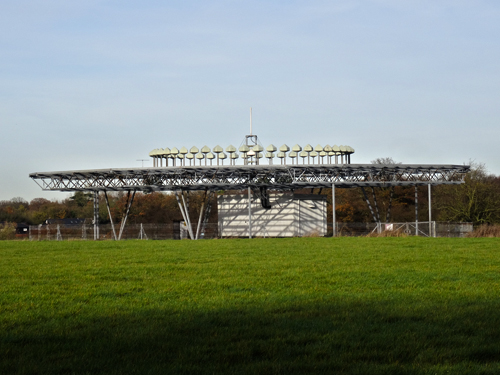
Brookman’s Park
The world’s radio infrastructure is extensive, but visibly declining. One of the consequences of the switch to digital is a new infrastructure of datacenters, carrier hotels, fiber optic cables and satellites, vast and mostly hidden: warehoused, anonymised, buried or in-orbit. This apparent distribution is also a canalisation, a redirection and constraint of what were once radiant signals, beamed out in all directions and detectable across huge areas.
The digital infrastructure is in the process of replacing the older one, built of radio masts and antennae. The elephant cages at Chicksands, Augsburg and Misawa. The HAARP array in the sub-arctic. The Duga radars in Ukraine and Siberia, whose sharp, repetitive 10 Hz rapping earned them the name of Russian Woodpeckers. An entire architecture dismantled, bull-dozed, run down or trucked away, amenities to a ghost town, as the spectra it served goes dark.
The VORs originate in the 1950s, first as mechanically-rotated, colour-coded visual and audio signals, and later as pure solid-state radio transmissions. From the 1960s, they became the dominant radio navigation system. Unlike non-directional beacons, which emit a constant reference point which must be combined with the aircraft’s own course data to produce a heading, the VOR produces its own direction information: a constant, omnidirectional master signal is broadcast at the same time as a sweeping, phased directional signal. Due North of the site, the two signals are perfectly matched. As the beam sweeps around, the difference in phase between the two signals gives the bearing relative to magnetic north.
The VORs are waymarks on the airways, intersections and turning points. Before the development of radio navigation, these signals were physically marked on the ground. In the 1920s, British air routes from Cairo to Baghdad followed fifty-foot route numbers painted on remote plateaus. Scattered across the United States, cast concrete arrows embedded in the earth pointed the way across the country for early airmail services. Today, aircraft travelling the jetways pass from VOR to VOR, criss-crossing the globe, their passage marked only by the sound of engines, and while they last, the grounded scaffolds of the VORs themselves.
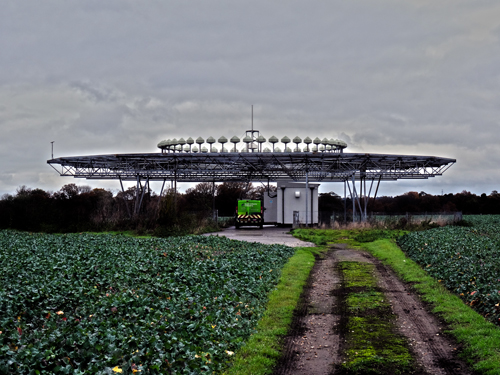
Ockham
During the first decade of the war in Afghanistan, concerns started to be raised about UK nationals fighting alongside the Taliban and al Qaeda. In 2009 a Birmingham man, Rashid Rauf, was killed in a CIA drone strike in Pakistan. Rauf was believed to have escaped from a Pakistani prison in 2007, and was wanted by British police in connection with a plot to bomb transatlantic airliners in August 2006. “He’s not the only [British Muslim] to die out here,” commented a security source.
For some time, RAF Nimrod R1 surveillance planes circling over Afghanistan had been picking up Taliban radio communications, and they often heard Bradford and Birmingham accents. As surveillance evolves, so does the target. Terrorists and drug dealers alike had learned to frequently swap mobile phones and SIM cards to make themselves electronically untraceable (a technique pioneered in Colombia, in the drug wars of the 90s). But the human voice is as unique as a fingerprint: in response, the security agencies developed techniques for searching vast quantities of voice traffic for people who sounded like suspects. A voice sample captured from an al-Jazeera television interview was used to pinpoint and capture Ramzi Binalshibh, a senior al-Qaeda operative, in September 2002.
In response to the fear of British Taliban, RAF aircraft with similar listening equipment began circling over British cities, looking for matching voice prints to those picked up in Afghanistan. Some time before, three Britten-Norman Islander aircraft based at RAF Northolt in West London were fitted out with the descendants of Wright’s RAFTER programme – wide-band receivers with the capacity to hoover up all the mobile voice calls in a city, coincidentally, “the size of Bradford”. The recordings are then shipped to GCHQ, whose vast supercomputing resources process the take, searching for voices heard far away, calling home to loved ones and potential accomplices.
Such operations have of course been going on since long before the current panic: a picture taken in 1999 shows MI5 agent Steven Lanham in a flight suit, leaning up against one of the Islanders. Lanham was killed in a motorbike crash in London later that year. Disguised as a courier, he was killed when a vehicle swerved across his path – ruled an accident, Lanham is nevertheless memorialised on the wall of those killed in action at Thames House, MI5’s Vauxhall headquarters. The latest wide-band receivers installed on the Islanders were developed in part by Gareth Williams, the GCHQ employee found naked and dead in a North Face holdall in the bathtub of an MI6 safe house in Pimlico in August 2010. Williams’ inquest found that his death was “unnatural and likely to have been criminally mediated.” A subsequent Metropolitan Police re-investigation concluded that Williams’s death was “probably an accident.” Williams also worked on electronic defences for the City of London’s banking systems, and had been seconded to Menwith Hill and Fort Meade. Today, light aircraft continue to circle over British cities, listening to all the phone calls, but like the VORs, they’re just the last few electromechanical avatars of far more pervasive covert infrastructures.
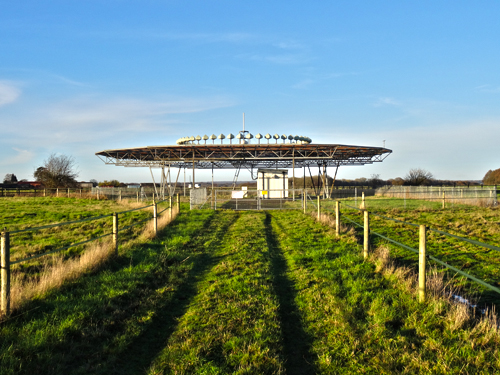
Bovingdon
You notice a lot of things just looking around – looking up, scanning the frequencies, poking screwdrivers into things, googling, or going out and walking the territory. The activities elide: a newspaper story leads to a planespotters forum leads to a wet carpark in Hertfordshire, watching people being loaded onto planes in the middle of the night. A lamp-post leads to a freedom of information request leads to a long-shuttered shop leads to a radar report loaded over 3G in another carpark on the other side of the city. Things happen in front of you. There are no secrets, only lazy researchers. I went out looking for VORs. I didn’t want to know it was all true.
The Ockham VOR is in a beetroot field. It’s cold and quiet, except for a Southern Electricity van coughing beneath the scaffolding. I tune my radio and at 115.30 MHz it squeals, the loudest noise for acres around. In another quiet field, besides a cemetery, a warm-looking house doesn’t know what its address connects it too, across a field of documents, a sheaf of insurance documents and requests for identification. William was from here – that one. The most obvious explanation is probably the right one.
At Lambourne, the VOR is marooned on a distant hill. You can circle it, but not approach it. It sits at the southern edge of Stapleford Airfield, where prospective pilots take off on wobbly dual flights, performing bumps and runs in the cold, clear air. Stapleford is the home of London Executive Aviation, whose 13-seater Embraer Legacy private jet was hired by the British government for some £50,000 to deport radical cleric Abu Qatada to Jordan, a country known to routinely use torture to extract confessions from suspects. (The deportation was conditional on a treaty regarding torture between the UK and Jordan; this treaty was subsequently ignored by the Jordanian courts.)
At Brookmans Park, the muddy track through woodland is festooned with surveillance warnings. Watch out for illegal tipping. An £80 penalty for littering. Rusty fences collapse into the dead autumn leaves. “The English horror of the countryside,” wrote Waugh, “its solitude and self-sufficiency, its bloody recreations, its darkness and silence and sudden, inexplicable noises, the kind of place where you never know from one minute to the next that you may not be tossed by a bull or pitchforked by a yokel or rolled over and broken up by a pack of hounds.”
Driving against the low sun through Hertfordshire, great tethered masts rear against the sky. The BBC’s Brookmans Park transmitting station is a strange outpost of the city in the regions: Reith’s own 1920s imposition on the landscape, “symbolising the status of broadcasting as a part of national life”. It was designed by Wimperis, Simpson & Guthrie, architects of Fortnum and Mason on Piccadilly and faced with Portland Stone, squatting among two hundred foot T-antennas and a forest of satellite dishes. Monumentally quiescent, Brookmans Park screams into the spectrum. Local residents, like those who live alongside Bessborough Gardens or in the shadow of Canada Square, hear the ghosts of radio programmes in their telephone calls, see them on their television screens. Radiators, wires and metal buckets close to the high-power transmitters sing out their signals.
Local ground truth is deceptive. The maps promise public pathways and private land intervenes, here as much as the metropolis. Perhaps more so. The Bovingdon VOR was built, like the others, in the 1960s, at the edge of an airfield. Like many of England’s airfields, it was established and run for the RAF’s bomber fleet in the 1940s, and transferred to the USAAF in 1942, initially as a base for the 92nd Bombardment Group, “Fame’s Favoured Few”. Eisenhower’s personal B-17 was based at Bovingdon, and Clark Gable, James Stewart and William Holden were all posted there. Today, mostly derelict, Bovingdon advertises itself as a filming location and a weekly market, cars parked on its kilometre-long runways punting bootleg DVDs and broken kettles.
Walking down the public right of way which runs beside the East/West runway, I am accosted by a man who roars up in a four-wheel drive. He gets out and stands, trembling with anger, fists balled, two feet away. What am I doing here? Why am I taking photos? He might have kids over there. I might be a paedo. The sun is setting and the English countryside radiates with colour. I am in the middle of a vast field edged by ancient woodlands and if I’m from the council he’ll take that camera and shove it up my arse. I give him my card. It says “Artist” on it. He does not give a fuck.
We’re scared of cameras when they have a man behind them; when that man is visible. (It’s almost always a man; at least when we see them. Ask other, but related, questions about the invisibility of Grace Hopper, of Hedy Lamarr, of so many others). The camera captures all of our misdeeds, it freezes them in time, makes them identifiable and attributable. But if we can’t see the person behind the camera; in the plane, vibrating at high altitude between the propellors, the person who takes the tapes out of the plane, who couriers them to Cheltenham, who feeds them into the water-cooled machine, who transfers that data into vast databases, who performs transformations on that data, who reads it, signs off on it, lives with the implications, associations and affects of that information – if we don’t see them, then we don’t attribute to them to the agency their role deserves.
Tune the dial. We live in such a tiny fragment of the electromagnetic spectrum. There’s cheap space there, and potential commons, but we’re afraid to talk about them. You walk into things, situations, that make you a little bit afraid. The Pompey Lads. Farnborough. The Nor. A trail of inference and messages on forums that say things like “OK Can we please stop the post on this frame… it might be safer.”
